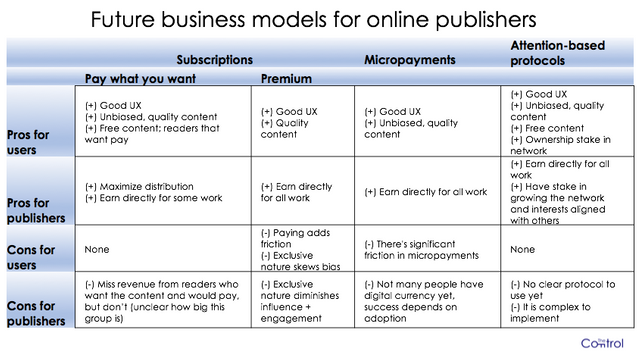What are the Future Business Models of the Consumer Web?
This week, Medium announced it is giving up on its ads driven biz model. What does the path forward look like for consumer web business models?
The Internet’s original sin is advertising. Ads became the de-facto business model because it was the easiest model for an Internet startup to implement and pitch to VCs. In that model, companies grow eyeballs so that they can sell those eyeballs to advertisers. That turned out to be a good decision for companies for a while, but people using the Internet have long suffered as a result.
Up until recently, the suffering had gone largely unnoticed. The user experience of ads was generally bad and the products weren’t as good as they could have been, but there weren’t alternatives. And the model generated significant revenues for companies that reached large consumer scale (it turned out 2 of the top 10 largest market cap companies in the world, Google and Facebook, did OK with that model).
But following all of the bad information that spread online during the 2016 U.S. Presidential election and the growing choice consumers have to opt out (via ad blockers), it is now clear that the consumer web needs better business models that incentivize publishers to produce quality content and truth rather than page views.
Medium is seeking to abolish the Internet’s original sin
Yesterday, Ev Williams announced that the company is trimming staff by 50 (mostly ad revenue focused people) and focusing the company on new business models.
The question then lies, what are those new business models? Ev doesn’t go into details in the post and I’m sure that we’ll see more on that from him soon. But I wanted to present the pros and cons (for both users and publishers) of the most likely revenue paths forward. I recently became a small-time publisher myself, once launched a micropayments product and am an active user of an attention-based blockchain protocol, so have thought a lot about this.

Subscriptions
Medium is currently offering a beta version of its Membership product for select publishers. Subscriptions come in two flavors:
Pay what you want: The Control is offering pay what you want subscriptions using the Medium Membership product. We offer all of our content for free, but if you want to support what we’re doing, you can pay $5/month (shameless plug). Patreon has popularized this model for content creators and it’s a valid model for publishers that want to maintain distribution and influence without relying on ads. Over time, if you’re putting out valuable content that people want, you should generate revenue. If you’re just maximizing for clicks and not creating quality content, no one will pay. I’m just a week into using this approach, but it’s vastly exceeded my expectations thus far.
Premium content behind paywall: The Information has popularized this model. It produces high quality content you can’t find elsewhere, all behind a paywall. This seems to be working; they have a number of high profile Silicon Valley people (among others) paying $39/month. The downside of this approach is that the content is exclusive and not seen by as many people as otherwise would see it. The mass influence of The Information suffers as a result (their non-existent social engagement is evidence of this).
Subscriptions is the model that Medium is most likely to focus on in the near-term. Both subscription approaches have downsides for publishers, but I don’t believe the pay what you want model has any significant downsides for users (which is why we went with it for The Control). Subscriptions is the easiest to implement as well, which always helps drive adoption (although as we saw with ads, easiest isn’t always best long-term).
Micropayments
Enabling payments of less than $1 has long been the promise of Bitcoin and closed loop payment services like Blendle. What if users could make small payments on-demand per page view directly to publishers? Wouldn’t that be great for publishers, allowing them to offer a great UX and get paid, and users, allowing them to get a better UX?
This is true — micropayments have clear benefits for both users and publishers. But the challenge here is twofold:
To date, no service has overcome the mental transaction costs associated with micropayments to the point of allowing consumers to really embrace the behavior. Blendle, using traditional payments in a closed network, has gained traction in certain regions where readers can’t get content elsewhere, but haven’t worked yet on a broader scale that.
For large publishers, not enough people have bitcoin (or any other service) yet to move the needle.
Brave is the most interesting company working on micropayments with its web and mobile browser with ad blocking and micropayments built-in. Brave actually does a good job reducing the mental transaction costs with a “pay what you want micropayment” model that allows you to set a monthly amount to pay to websites, and then allocates those payments based on your traffic in a given month.
The challenge for Medium here is that the total user base of Bitcoin users is still relatively small (~10M) compared to the Medium user base (+30M). Micropayments is unlikely to be the path Medium focuses on in the near-term, but should be strongly considered as more people get digital currency.
Attention-based protocols
An attention-based protocol is a user-owned social network with a set of rule agreed up by all of the users where ones ownership stake reflects influence on the attention of the network. The attention in the network is determined by the largest stakeholders and there is no centralized censorship. Steem is the best current example of an attention-based blockchain protocol. Think of how the current Medium platform would change if every creator of Medium owned an ownership stake in Medium and could earn more ownership by publishing quality content and exert more influence by earning more ownership.
I believe that the attention-based blockchain protocol will be the most successful long-term model of the three because it’s best for users and what’s best for the users wins in the long-run (though this long-run could be very far out). With this approach, users get a great UX, quality, unbiased content and an ownership stake in the network they’re using. Having a stake in the network incentivizes all actors to contribute positively to the network to increase that ownership stake.
Given the scale of Medium presently and the large publishers they’re serving, they’re unlikely to go this route but I hope they at least explore it. It may greatly impact the future of publishing and it could pay to be at the forefront.
Great products win
Medium is a great product first and foremost and it is always wise to bet on great products. It’s why I chose Medium for The Control. But it’s clear that the scale of the company’s success will depend on it’s ability to navigate the murky waters of non-advertising consumer web business models.
If Medium does not go the route of attention-based blockchain protocols, the threat is that others that do, like Steemit, build a better product (in which case, it will be game over Medium). It will be fun to watch this play out over the coming years!
NOTE: THIS WAS ORIGINALLY PUBLISHED ON THE CONTROL

About me: I run The Control and am an investor at Runa Capital, an early stage venture fund. Previously, I worked on business development and marketing at Coinbase and as an Associate at North Atlantic Capital. My work has been featured in publications like the Wall Street Journal and Entrepreneur and I’ve guest lectured at the Yale School of Management.